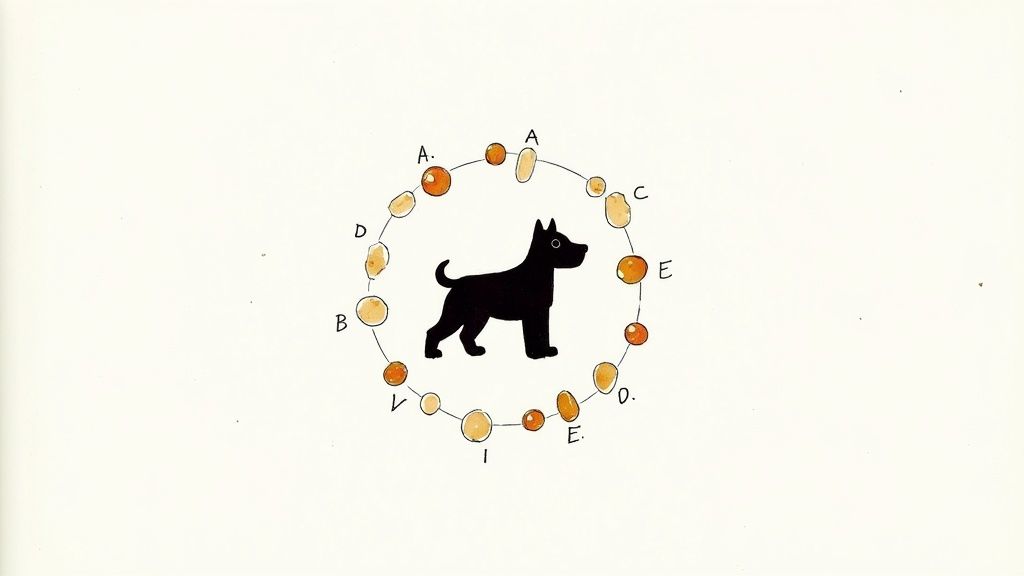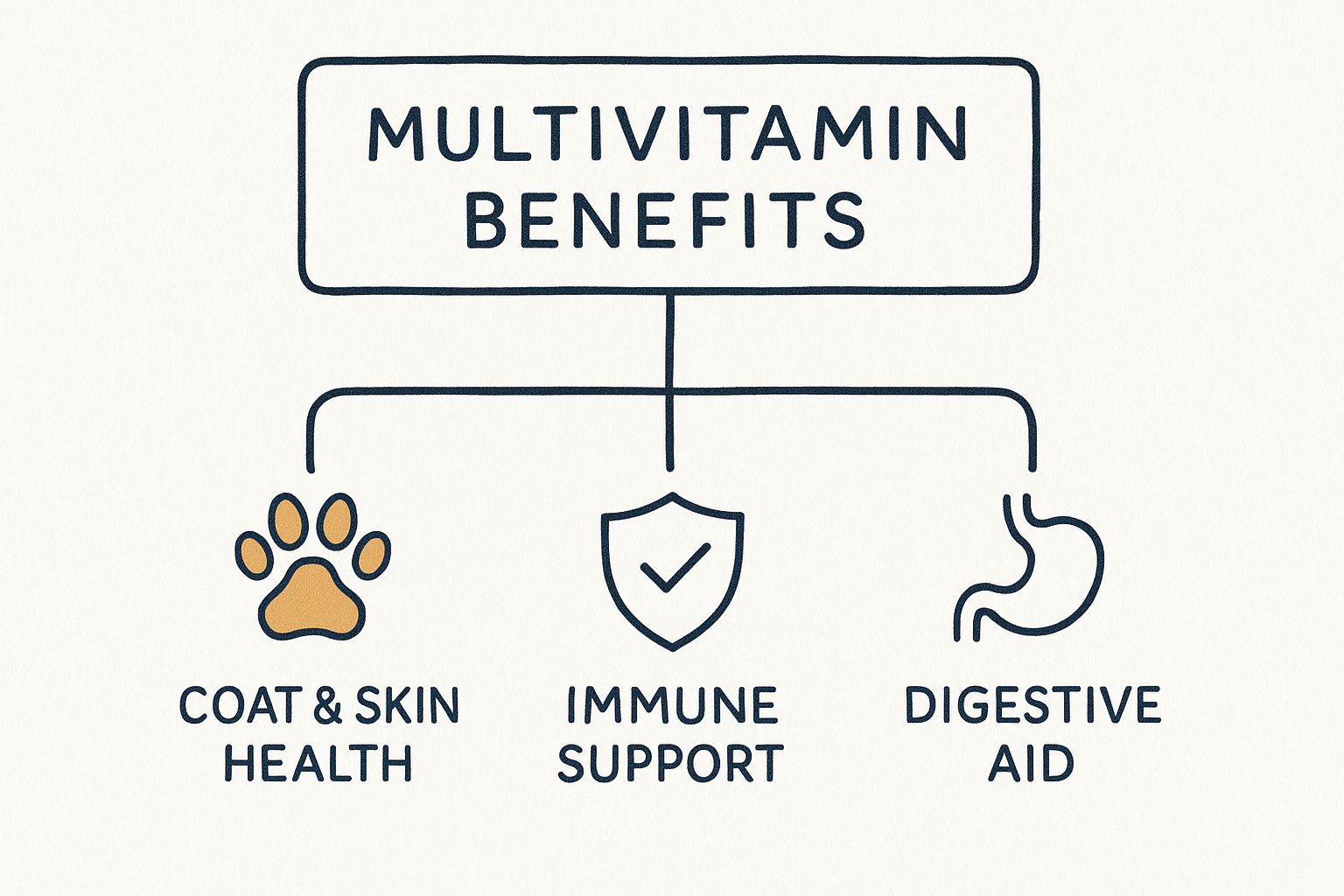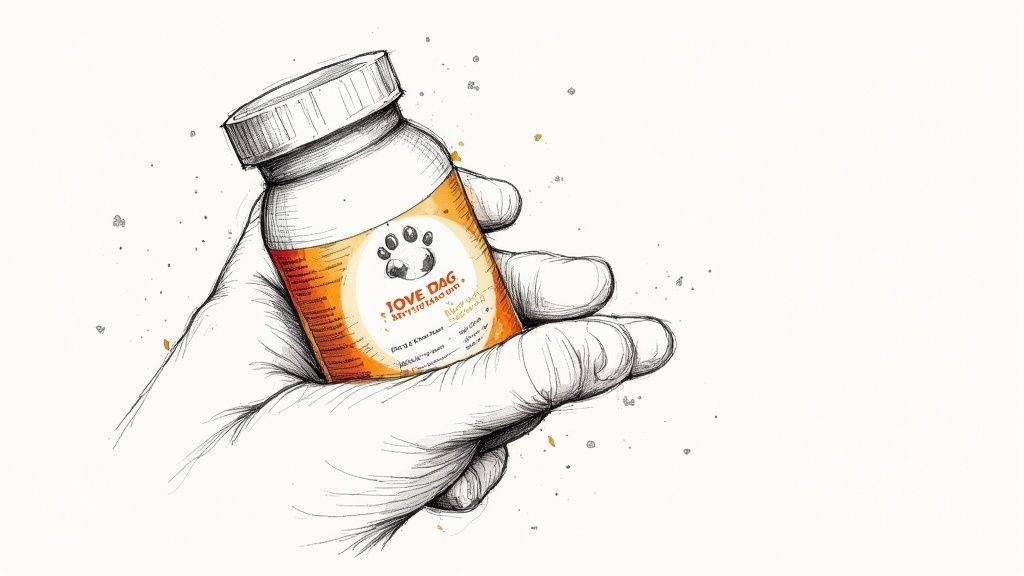A good quality commercial dog food is formulated to be complete and balanced, but sometimes life throws a curveball. In certain situations, a multivitamin for dogs can act as a valuable nutritional safety net. It’s never a replacement for a proper diet, but it can be a fantastic supportive measure to fill in any potential blanks. This is particularly true for dogs on homemade diets, those who are fussy eaters, or seniors with evolving health needs.
Do Dogs Actually Need a Multivitamin?

Let's get straight to the big question. For a healthy adult dog on a high-quality, commercial diet that meets established nutritional guidelines, a daily multivitamin often isn't necessary. These foods are meticulously designed to give your canine companion all the essential vitamins and minerals they need to flourish.
However, life isn't always so straightforward. Just like us, some dogs face circumstances that ramp up their nutritional demands or create small gaps their regular meals might not quite fill. Think of it less as a daily must-have for every dog and more as a targeted tool to bolster their health when it's needed most.
When a Supplement Makes Sense
A multivitamin can be a real game-changer in several common scenarios. It’s not about trying to fix a poor diet, but rather about optimising a good one when a little extra support is called for.
Here are a few situations where a supplement could provide that welcome nutritional boost:
- Homemade Diets: Even with the best of intentions, it's surprisingly easy for homemade or raw diets to be deficient in certain micronutrients. A multivitamin helps ensure you're covering all the bases.
- Picky Eaters: If your dog regularly sniffs at their food and walks away, or just eats inconsistently, they could be missing out on key nutrients over the long run.
- Senior Dogs: As dogs get older, their bodies can become less efficient at absorbing nutrients. Their needs also shift, often requiring more support for their joints, brain function, and immune system.
- Highly Active Dogs: Canine athletes and working dogs burn through calories and nutrients at an incredible rate. A supplement can help replenish what they use up.
Think of a multivitamin as a supportive measure, not a cure-all. It works in partnership with a balanced diet and proper veterinary care to help you take a proactive and informed approach to your dog's long-term health.
At the end of the day, the goal is to provide a complete nutritional profile for your best mate. While a top-notch kibble is always the foundation, a well-chosen multivitamin acts as a kind of insurance policy, ensuring your dog has everything they need to live a happy, healthy life—especially during times of increased stress or the challenges that come with ageing. Your vet is always the best person to chat with first.
The Real Benefits of a Canine Multivitamin

It’s easy to look at a list of ingredients on a supplement tub and see just a jumble of letters and numbers. But understanding what a multivitamin for dogs really does means looking past the label and seeing how those nutrients work together to support your dog from the inside out.
Think of it like a team of tiny specialists, each with a crucial job, all working to keep your dog's body running like a well-oiled machine. This isn't just about plugging nutritional gaps; it's about providing a comprehensive support system for their health, energy, and overall zest for life. Let’s break down how these ingredients deliver real results you can often see with your own eyes.
Cellular Bodyguards and Energy Managers
On a microscopic level, your dog's body is in a constant battle with environmental stressors and the simple process of ageing. This is where antioxidants step in to save the day.
- Vitamins C and E: Consider these the cellular bodyguards. They seek out and neutralise nasty free radicals—unstable molecules that can damage cells and accelerate ageing. By protecting cells, they help maintain a strong immune system.
- B Vitamins: These are the body's energy factory managers. They are absolutely vital for turning the food your dog eats into fuel, keeping them playful, alert, and ready for the next walk.
This shift towards proactive, preventative care is becoming more and more common. In the UK, the pet nutraceuticals market, which includes supplements like a multivitamin for dogs, was valued at around $279.8 million USD in 2025. Experts predict this will climb to $446 million by 2030. Dogs make up the lion's share of this, at about 55%, as owners increasingly look for ways to support their pets' long-term health.
Supporting a Healthy Gut Microbiome
A happy gut is the foundation of good health, influencing everything from digestion to their immune response. While not always standard in a basic multivitamin, many top-tier formulas now include ingredients to support this incredibly important system.
"A well-formulated multivitamin can offer more than just basic nutrition. By including prebiotics or probiotics, it can actively contribute to a thriving gut environment, which is fundamental to a dog's immune response and nutrient absorption."
These beneficial gut bacteria are essential for breaking down food so your dog can absorb all the good stuff. They're also the first line of defence against harmful pathogens. To get a better handle on this, have a look at our guide on prebiotics and probiotics for dogs, which dives deeper into how these elements boost digestive health.
Visible Signs of Inner Health
One of the best parts of giving your dog targeted nutritional support is actually seeing the difference it makes. A quality multivitamin can produce tangible improvements that let you know it's doing its job.
You might start to notice a shinier, healthier coat and less dry, flaky skin. That’s often down to ingredients like Omega fatty acids, biotin, and zinc working their magic.
Plus, many formulas designed for senior or very active dogs include glucosamine and chondroitin. These are brilliant for supporting joint health, helping to keep your dog mobile and comfortable so they can enjoy their favourite activities for years to come. It’s these visible benefits that show how the right multivitamin for dogs truly contributes to a happy, vibrant life.
How to Read a Dog Multivitamin Label
Walking down the pet supplement aisle can be a bit bewildering, can't it? Every colourful bottle and bag seems to make a bold promise. So, how do you cut through the marketing noise and find something that will genuinely benefit your dog? It all comes down to one crucial skill: learning how to read the label.
Looking past the flashy packaging and focusing on the small print is the best way to choose a quality multivitamin for dogs. Think of the label as the product's CV. It reveals everything, from the powerhouse ingredients doing the hard work to the fillers that just add bulk. A good supplement is an open book, listing high-quality, recognisable ingredients without hiding behind confusing terms.
The infographic below gives a great visual overview of what a good multivitamin can support.

As you can see, a well-formulated supplement provides support from nose to tail, contributing to everything from a glossy coat to strong joints and a resilient immune system.
Decoding the Guaranteed Analysis
The first place your eyes should go is the Guaranteed Analysis. This isn't just marketing fluff; it's a legally required breakdown of the minimum and maximum amounts of each nutrient in a single serving. It’s your at-a-glance guide to the product's potency.
Here, you’ll see a list of vitamins and minerals followed by a number, like "Vitamin E... 50 IU" or "Zinc... 10 mg." This tells you exactly how much of each nutrient is packed into a single chew or scoop. It’s the most direct way to compare the strength of different products side-by-side.
Scrutinising the Ingredient List
Next, flip the package over and find the main ingredient list. This is where the real detective work begins, as it tells you about the quality of the formula. Ingredients are always listed in descending order by weight, so the first few items on the list make up most of the product.
What should you look for?
- Active Ingredients: These are the reason you're buying the supplement in the first place. Think vitamins (A, D, E), minerals (calcium, zinc), and functional extras like glucosamine for joints or Omega-3s for skin health. Make sure they are listed clearly.
- Inactive Ingredients: These are the components that bind the tablet, add flavour, and keep it fresh. Look for natural, wholesome additions like sweet potato, chicken liver, or brewer's yeast. Be cautious of products loaded with artificial colours, chemical preservatives like BHA or BHT, or cheap fillers like corn and soy.
A premium multivitamin prioritises high-quality, functional ingredients over cheap fillers. The ingredient list should read like a recipe for good health, not a list of synthetic chemicals.
This demand for quality is having a huge impact. In the UK pet nutraceuticals market, vitamins and minerals make up the largest slice of the pie, accounting for about 27.07% of total revenue. This focus on supplements like the multivitamin for dogs is a key reason the industry is expected to be worth around $715.7 million USD by 2030. You can read more about these trends in the detailed report on pet nutraceuticals from Grand View Research.
By learning to look beyond the marketing slogans, you can make a properly informed choice. A quick scan of the Guaranteed Analysis and a careful read of the ingredient list gives you all the information you need to pick a safe, effective, and high-quality multivitamin that will truly support your dog’s health.
Choosing the Right Multivitamin for Your Dog

Walking down the supplement aisle for your dog can feel a bit much, can't it? With so many options, picking the right multivitamin for your dog seems complicated. But it doesn't have to be.
The secret is to think less about a generic "all-in-one" fix and more about your individual dog. It's just like choosing their food—what a bouncy puppy needs is completely different from what a wise old senior requires.
A great place to start is your dog's age. A young, growing pup has huge nutritional demands for building strong bones and a sharp mind. An adult dog in its prime needs something different to maintain its health, while a senior will likely benefit from extra joint support or ingredients to keep them mentally spry. Matching the multivitamin to their life stage is a simple way to make sure it's actually doing some good.
Consider Your Dog's Specific Health Goals
Once you've factored in age, think about what you're hoping to achieve. Are you aiming for a shinier, healthier coat? Or perhaps you want to give their joints a bit of help for those long weekend walks? Many multivitamins are designed with specific outcomes in mind.
- For Skin and Coat: Keep an eye out for formulas packed with Omega-3 and Omega-6 fatty acids, zinc, and biotin. These are the building blocks for healthy skin and a glossy coat. Our guide on dog skin supplements has even more detail on this.
- For Joint Support: Key ingredients like glucosamine, chondroitin, and MSM are brilliant for maintaining healthy cartilage. They’re especially helpful for older dogs or very active breeds.
- For Overall Wellness: A good, balanced multivitamin with essential vitamins (like A, D, and E) and minerals provides a fantastic foundation for their daily health.
It's clear that more and more dog owners are seeing the value in this. The global dog multivitamin market was valued at around $525 million USD and is expected to climb to nearly $801 million USD by 2031. This isn't just a fad; it's a reflection of owners wanting the very best for their dogs.
Brand Reputation and Vet Consultation
It's also worth doing a little digging into the brand itself. A trustworthy company will be open about its ingredients, where they come from, and how its products are made. Look for brands that use third-party testing—it’s an independent stamp of approval that what’s on the label is actually in the bottle.
By far the most important step, however, is to have a chat with your vet. They have the full picture of your dog's health and can give you tailored advice that truly fits their needs. This ensures any supplement you choose is both safe and beneficial.
Finally, think about the practical side of things. If you have a fussy eater, a powder sprinkled on their food might get a firm "no." But a tasty, flavoured soft chew? That might just be seen as a daily treat. Choosing a format your dog actually likes will make supplement time a happy routine instead of a daily battle.
Common Mistakes to Avoid When Giving Supplements
Giving your dog a supplement feels like a great way to show you care, but it’s crucial to do it safely. A few common missteps can easily turn a well-intentioned act into a potential problem. By steering clear of these pitfalls, you can make sure the multivitamin for dogs you’ve chosen is actually helping them.
One of the biggest and most dangerous mistakes is thinking 'more is better'. It's a tempting trap to fall into—if one little chew is good, two must be fantastic, right? Unfortunately, that’s not how it works. Unlike water-soluble vitamins that the body can easily flush out, fat-soluble vitamins like A and D can build up to toxic levels, leading to serious health complications. Always, always stick to the recommended dose on the packet.
Another critical error is giving your dog human vitamins. Our nutritional needs are worlds apart from theirs, and human supplements are formulated specifically for our bodies. What’s worse, many human vitamins, especially the chewable or gummy kinds, contain xylitol. This artificial sweetener is extremely poisonous to dogs and can cause severe, life-threatening illness even in small amounts.
Introducing a New Supplement Correctly
Suddenly tossing a new supplement into your dog’s dinner bowl can sometimes lead to an upset stomach. This doesn’t necessarily mean the product is bad, but simply that their digestive system needs a little time to adjust.
A slow and steady introduction is always the best way to go:
- Start with half a dose: For the first 3-5 days, give your dog half the recommended amount.
- Watch them closely: Keep an eye out for any digestive changes, like loose stools or vomiting.
- Move up to the full dose: If all seems well, you can gradually increase to the full recommended serving.
This simple process gives their body time to get used to the new ingredients and really minimises the risk of any tummy troubles.
Remember, the dosage instructions are based on your dog's weight for a reason. A tiny terrier has vastly different nutritional requirements than a Great Dane. Never guess the amount—read the label carefully.
Overlooking the Bigger Picture
Finally, it’s vital not to view a multivitamin as a replacement for a high-quality diet or proper veterinary care. A supplement is there to support an already balanced lifestyle, not to fix a poor one. If your dog is showing signs of illness or you have specific concerns like joint stiffness, a supplement can be a helpful tool, but it's never a substitute for a professional diagnosis from your vet.
For example, while a good multivitamin might contain ingredients for joint health, you might want to explore more targeted options for a dog with mobility issues. Our detailed article on choosing the right joint supplement for dogs offers deeper insight into this specific area. Always work in partnership with your vet to build a complete health plan for your furry best mate.
Got Questions About Dog Multivitamins? We've Got Answers
Stepping into the world of canine supplements can feel a bit overwhelming, and it's natural to have questions. To help you make the best choice for your furry friend, we've tackled some of the most common queries we hear from dog owners.
Can I Just Give My Dog a Human Multivitamin?
That’s a hard no. It might seem convenient, but human multivitamins are designed for human bodies, not canine ones. They often contain levels of certain vitamins, like Vitamin D, that can be toxic to dogs in those doses.
What’s even more dangerous is that many human gummy or chewable vitamins are sweetened with xylitol. This ingredient is incredibly poisonous to dogs, and even a tiny amount can lead to life-threatening health emergencies. Always, always stick to products made specifically for dogs.
How Long Before I See a Difference?
When it comes to supplements, think marathon, not sprint. Consistency is everything, and the time it takes to see a noticeable change really depends on what you're hoping to achieve.
- For a healthier-looking coat: You could start seeing a new shine and softness in as little as 3-4 weeks.
- For better joint support: Give it a bit longer. It can often take 4-6 weeks of daily use to see a real improvement in your dog's mobility and comfort.
- For overall health and wellness: This is more about playing the long game. You might not see a dramatic outward change, because the real work is happening on the inside, filling nutritional gaps and supporting long-term health.
Think of a multivitamin as a supportive partner in your dog’s health journey, not a magic pill. It’s the consistent, daily use that allows those high-quality ingredients to get to work and deliver their full benefits over time.
My Dog Is on a Special Diet from the Vet. Do They Still Need One?
Probably not. When a vet prescribes a specific diet, it's usually for a very good reason, like managing kidney disease or tackling food allergies. These foods are meticulously formulated by veterinary nutritionists to be perfectly balanced for that particular condition.
Adding a multivitamin into the mix could throw that delicate balance completely off. You might end up giving too much of a certain nutrient, which could actually interfere with the diet's purpose or even cause harm. Before you add any supplement to a prescription diet, have a chat with your vet. They know your dog's full health picture and can give you the best advice.
Ready to give your dog's health a boost with a top-quality, vet-approved supplement? Explore the full range of natural and effective chews at Tipaw and find the perfect formula for your best mate. Visit the Tipaw store to learn more.





